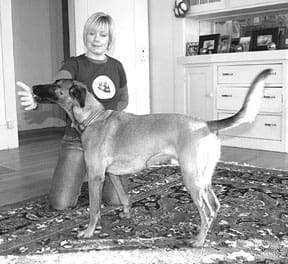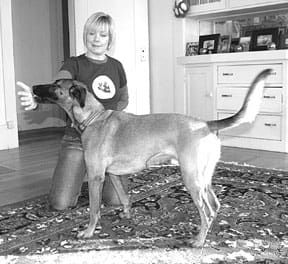[Updated June 12, 2018]
Each month, I stand in the middle of my training center during the second session of my newest Level One class and introduce my students to the “Targeting” exercise. “Targeting,” I say, “is teaching your dog to touch his nose to a target, on cue.” Each month, I am invariably met with a half-dozen blank stares. I can read my students’ unanimous thoughts. “Why on earth,” they are clearly thinking, “would I want to teach my dog to do that?” Their initial lack of enthusiasm for this exercise is understandable. Targeting is not presented in most of the top-selling dog training books on the market, and only in recent years have modern dog trainers started to include it in their class curriculums. Once my students get past their skepticism, however, most of them are as hooked on targeting as I am – even my dogs have become hooked!
There are dozens of reasons to teach your dog to target. It’s fun and it’s easy. It’s the perfect exercise for helping you to see the learning “light bulb” go on in your dog’s brain. Most dogs love targeting, which makes it a handy tool for getting your dog’s attention in a distracting environment, as well as making it a great parlor trick to show off to family and friends.

Targeting is also a wonderfully useful tool for helping timid dogs gain confidence. It is the foundation behavior for teaching your dog a multitude of more complex behaviors, such as ringing a bell on a string at the door to tell you he has to go outside, turning light switches on and off, closing doors, teaching a suspicious dog to come when called, retrieving, learning object discrimination, pausing in the required contact zones in Agility competition, and doing “go-outs”- used in advanced levels of obedience competition and in good manners exercises such as “Go To Your Place,” where the dog goes and lies down on his bed or rug – to name just a few.
In fact, targeting is one of my all-time favorite exercises. It may be hard to fathom how one exercise can accomplish all of the incredible things listed above, but as I say to my blankly-staring students: Trust me. You and your dog will love it.
Teach Your Dog to Target
It’s ridiculously easy to teach your dog to target. Hold out your open hand at your dog’s nose level, palm facing him, fingers pointed toward the ground. When he sniffs or licks your hand, Click! your clicker (or say “Yes!”) and give him a treat from your other hand (see photos, next page). Make sure his nose actually touches your skin – “close” only counts in horseshoes. Plus, you must endeavor to Click! the instant his nose makes contact with your skin. If you consistently Click! too soon, you will teach him to stop before he touches you. If you consistently Click! too late, you will teach him that moving his nose away from you is the way to earn a reward.
When you have clicked and rewarded your dog’s first touch, remove your target hand, then offer it again, in the same position. When he sniffs, Click! and treat. Do it again. And again. (Notice we have not used a verbal cue yet.)
Most dogs will do the initial sniff easily. If your dog doesn’t sniff your offered palm, rub some hot dog or other tasty, moist treat on your skin to make your hand more enticing. Most dogs will sniff your newly-offered hand a few times and then ignore it, looking directly at your treat hand. You can almost hear them say, “Why am I looking at this hand? The GOOD STUFF comes from over there!” When this happens, hide your treat hand behind your back, offer him the target hand, and wait. He should soon sniff the offered hand. If he doesn’t, rub a treat on it and offer it again. If that doesn’t do it for him, take a step or two backward and offer him the target as he moves toward you. Click! and treat.
Repeat this step over and over, until he deliberately bumps your hand with his nose. This is the heart-stopping “Aha!” moment that positive trainers love – when you can see that your dog knows that the way to make the Click! happen is to touch your hand. Some dogs “get it” very quickly. Louis, a Border Collie client of mine in Santa Cruz, California, got it in three repetitions. Others take longer for the light bulb to go on, depending on variables such as the owner’s skill and timing, the dog’s interest in the training game, the desirability of the treat reward, and the level of distractions in the surrounding environment. You can enhance your dog’s learning speed by working in a quiet location, using very delicious treats and paying attention to your Click! timing.
Most of the behaviors that utilize the “Touch” are somewhat complex to train. Remember to keep your training sessions short, and if either you or your dog are getting frustrated, do something easy and fun to end the session, then take a break and try it again later.
Adding Verbal Marks to Targeting
Once your dog is deliberately bumping your hand with his nose you can add the verbal cue. Start saying “Touch!” just before his nose touches your skin. Click! and reward. Gradually offer the verbal cue earlier and earlier, until he has had the opportunity to associate the verbal cue with the targeting behavior and is responding to the cue.

Now we raise the bar. So far, your dog understands that he is supposed to touch his nose to your hand when he is sitting in front of you and the target is presented to him, directly in front of him, at nose level. It’s time to change the criteria.
Now you want him to touch the target wherever it is, even if it’s moving. Back away from him, offer the target and say “Touch.” As he gets up to follow you, keep moving slowly backward. When he catches up to you and touches the moving target, Click! and treat. Move your hand off to one side and ask him to touch it. Click! and treat. Move it to the other side. Move it lower, toward the floor. Move it higher, so he has to jump up to touch it. Put it above a chair seat, so he has to place his front feet on the chair to reach up and touch it.
When he’s really confident about touching the target, put the behavior on a schedule of random reinforcement – ask him to touch two times before you Click! and treat. Then three times. Then once. Then once. Then four times. Then two times. Vary the number of times you ask him to touch before he gets clicked; don’t always make it harder and harder or he may get frustrated and give up.
How to Add New Targets
If you want your dog’s targeting behavior to be really versatile, you now need to teach him to touch other targets. I teach the target stick next. (Some trainers start by using the stick as the training target. I prefer starting with the target hand, because most dogs naturally want to sniff our hands, and because some dogs are initially intimidated by a stick in their owners’ hands.)
A target stick can be a small branch off a tree, a dowel from the hardware store, a pencil or Tinkertoy (for small dogs), or an “official” target stick purchased from a pet supply source. If you are using a homemade stick, wrap a piece of colored tape around one end to designate the actual target. Accept touches near the tape at first, but ultimately shape the touches to the actual target by clicking only those touches that get closer and closer to the tape.
Hold your target stick vertically with the target end near your dog’s nose; if a vertical position doesn’t work, try holding it horizontally (as shown below). Some dogs will sniff the end of the target stick the first time you offer it. Click! and treat. Others may need a bit of hot-dog rubbed on the end to motivate them to touch this new object. Still others will be afraid of the stick. If your dog is leery of the stick, hold it so most of it is hidden behind you and only an inch of the tip protrudes from your hand.
Strengthen Your Dog’s Targeting
When your dog will touch the tip, extend the stick a little at a time, until he is touching it at its full length. “A little at a time” will vary from one dog to the next. Some dogs will accept a six-inch increase at a time, others will tolerate only half-inch increments. Start small to avoid frightening your dog, and work up to larger increases if he seems to be tolerating them well.
As soon as your dog is readily touching the tip of the stick, at whatever length, start using the verbal “Touch” cue again to elicit the targeting behavior. When he is proficient at touching the target stick, you can use it to extend your reach. With three feet of arm length and three feet of target stick you can get him to touch things a full six feet away from you. If you place the tip of the target stick against a door, wall or other object, you can start teaching him to touch other things, including people.
This is a useful tool for encouraging a timid dog to be brave. When he is very confident about touching his target stick you can place the target closer and closer to a scary object and he will become braver about approaching it.
Targeting is Useful for Tricks
You can also teach your dog to touch other things by holding the intended target object in your hand. I like teaching dogs to ring a bell hanging on a string from your doorknob to tell you he has to go outside. It’s easy – if you take it one step at a time.
First teach him to ring the bell hanging from a string in your hand. Then have him touch the bell when it’s hanging on the door, with your hand held near. Gradully withdraw your hand, and then start slowly moving your entire self away from the door until you can send him across the room to ring the bell on your verbal cue.
As soon as he is proficient at ringing the bell on the doorknob, start asking him to ring the bell every time you take him outside. Although we frequently use a treat as the reward for the Click!, if your dog is thrilled about a trip to the yard, letting him out is an even better reward at that moment than a food treat. If you start making the bell a consistent part of his “going out” routine, and keep asking him to ring the bell from greater and greater distances, you should be able to “fade” (gradually eliminate) the “Ring the Bell” cue, and he will learn to run to the bell and ring it to tell you that he has to go outside.
There is no limit to the ways that you can utilize the touch behavior to accomplish behaviors you like. You can move your dog into heel position (and keep him there) by using your hand as a target next to your leg. You can teach him to close cupboard doors by having him target to a spot on the door. You can teach him to turn lights on and off by pushing up on a stick attached to a light switch or by touching a “Touch Lamp” with his nose.
You can also teach your dog object discrimination by having him learn to identify and touch various objects (or people) by name. The opportunities for application of the touch behavior are virtually endless – limited only by your creativity.
Now, if you’ll excuse me, I’m going to go use targeting to teach my Pomeranian to bowl!
Thanks to trainer Sandy Thompson, of Sirius Puppy Training in Berkeley, California, for her help demonstrating these techniques in these photographs.






